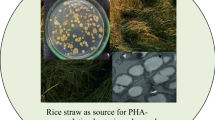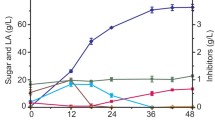Abstract
Enterobacter cloacae NRRL B-23289 was isolated from local decaying wood/corn soil samples while screening for microorganisms for conversion of l-arabinose to fuel ethanol. The major product of fermentation by the bacterium was meso-2,3-butanediol (2,3-BD). In a typical fermentation, a BD yield of 0.4 g/g arabinose was obtained with a corresponding productivity of 0.63 g/l per hour at an initial arabinose concentration of 50 g/l. The effects of initial arabinose concentration, temperature, pH, agitation, various monosaccharides, and multiple sugar mixtures on 2,3-BD production were investigated. BD productivity, yield, and byproduct formation were influenced significantly within these parameters. The bacterium utilized sugars from acid plus enzyme saccharified corn fiber and produced BD (0.35 g/g available sugars). It also produced BD from dilute acid pretreated corn fiber by simultaneous saccharification and fermentation (0.34 g/g theoretical sugars).
Similar content being viewed by others
Author information
Authors and Affiliations
Additional information
Received: 17 December 1998 / Revision received: 9 March 1999 / Accepted: 20 March 1999
Rights and permissions
About this article
Cite this article
Saha, B., Bothast, R. Production of 2,3-butanediol by newly isolated Enterobacter cloacae . Appl Microbiol Biotechnol 52, 321–326 (1999). https://doi.org/10.1007/s002530051526
Issue Date:
DOI: https://doi.org/10.1007/s002530051526




